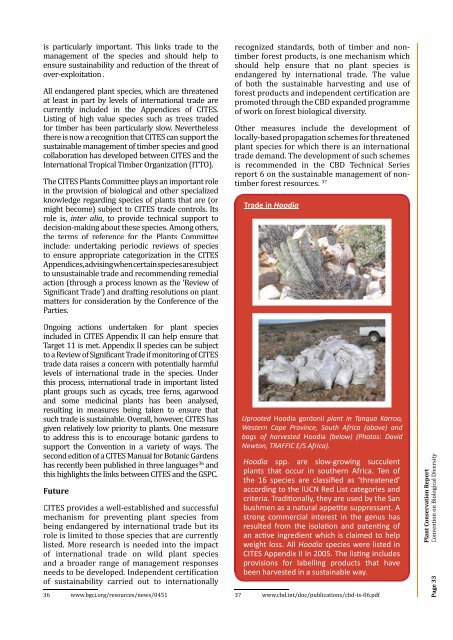from the global partnership for plant conservation
from the global partnership for plant conservation
from the global partnership for plant conservation
Create successful ePaper yourself
Turn your PDF publications into a flip-book with our unique Google optimized e-Paper software.
is particularly important. This links trade to <strong>the</strong>management of <strong>the</strong> species and should help toensure sustainability and reduction of <strong>the</strong> threat ofover-exploitation .All endangered <strong>plant</strong> species, which are threatenedat least in part by levels of international trade arecurrently included in <strong>the</strong> Appendices of CITES.Listing of high value species such as trees traded<strong>for</strong> timber has been particularly slow. Never<strong>the</strong>less<strong>the</strong>re is now a recognition that CITES can support <strong>the</strong>sustainable management of timber species and goodcollaboration has developed between CITES and <strong>the</strong>International Tropical Timber Organization (ITTO).The CITES Plants Committee plays an important rolein <strong>the</strong> provision of biological and o<strong>the</strong>r specializedknowledge regarding species of <strong>plant</strong>s that are (ormight become) subject to CITES trade controls. Itsrole is, inter alia, to provide technical support todecision-making about <strong>the</strong>se species. Among o<strong>the</strong>rs,<strong>the</strong> terms of reference <strong>for</strong> <strong>the</strong> Plants Committeeinclude: undertaking periodic reviews of speciesto ensure appropriate categorization in <strong>the</strong> CITESAppendices, advising when certain species are subjectto unsustainable trade and recommending remedialaction (through a process known as <strong>the</strong> ‘Review ofSigniicant Trade’) and drafting resolutions on <strong>plant</strong>matters <strong>for</strong> consideration by <strong>the</strong> Conference of <strong>the</strong>Parties.recognized standards, both of timber and nontimber<strong>for</strong>est products, is one mechanism whichshould help ensure that no <strong>plant</strong> species isendangered by international trade. The valueof both <strong>the</strong> sustainable harvesting and use of<strong>for</strong>est products and independent certiication arepromoted through <strong>the</strong> CBD expanded programmeof work on <strong>for</strong>est biological diversity.O<strong>the</strong>r measures include <strong>the</strong> development oflocally-based propagation schemes <strong>for</strong> threatened<strong>plant</strong> species <strong>for</strong> which <strong>the</strong>re is an internationaltrade demand. The development of such schemesis recommended in <strong>the</strong> CBD Technical Seriesreport 6 on <strong>the</strong> sustainable management of nontimber<strong>for</strong>est resources. 37Trade in HoodiaOngoing actions undertaken <strong>for</strong> <strong>plant</strong> speciesincluded in CITES Appendix II can help ensure thatTarget 11 is met. Appendix II species can be subjectto a Review of Signiicant Trade if monitoring of CITEStrade data raises a concern with potentially harmfullevels of international trade in <strong>the</strong> species. Underthis process, international trade in important listed<strong>plant</strong> groups such as cycads, tree ferns, agarwoodand some medicinal <strong>plant</strong>s has been analysed,resulting in measures being taken to ensure thatsuch trade is sustainable. Overall, however, CITES hasgiven relatively low priority to <strong>plant</strong>s. One measureto address this is to encourage botanic gardens tosupport <strong>the</strong> Convention in a variety of ways. Thesecond edition of a CITES Manual <strong>for</strong> Botanic Gardenshas recently been published in three languages 36 andthis highlights <strong>the</strong> links between CITES and <strong>the</strong> GSPC.FutureCITES provides a well-established and successfulmechanism <strong>for</strong> preventing <strong>plant</strong> species <strong>from</strong>being endangered by international trade but itsrole is limited to those species that are currentlylisted. More research is needed into <strong>the</strong> impactof international trade on wild <strong>plant</strong> speciesand a broader range of management responsesneeds to be developed. Independent certiicationof sustainability carried out to internationally36 www.bgci.org/resources/news/0451Uprooted Hoodia gordonii <strong>plant</strong> in Tanqua Karroo,Western Cape Province, South Africa (above) andbags of harvested Hoodia (below) (Photos: DavidNewton, TRAFFIC E/S Africa).Hoodia spp. are slow-growing succulent<strong>plant</strong>s that occur in sou<strong>the</strong>rn Africa. Ten of<strong>the</strong> 16 species are classified as ‘threatened’according to <strong>the</strong> IUCN Red List categories andcriteria. Traditionally, <strong>the</strong>y are used by <strong>the</strong> Sanbushmen as a natural appetite suppressant. Astrong commercial interest in <strong>the</strong> genus hasresulted <strong>from</strong> <strong>the</strong> isolation and patenting ofan active ingredient which is claimed to helpweight loss. All Hoodia species were listed inCITES Appendix II in 2005. The listing includesprovisions <strong>for</strong> labelling products that havebeen harvested in a sustainable way.37 www.cbd.int/doc/publications/cbd-ts-06.pdfPlant Conservation ReportPage 33 Convention on Biological Diversity
















